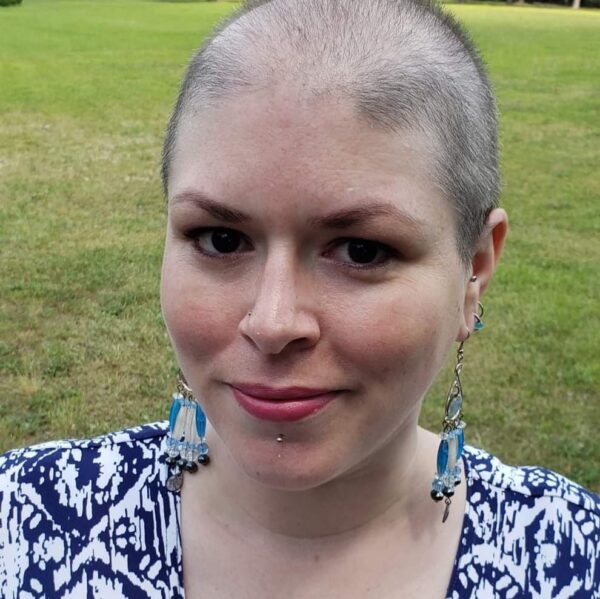“It’s just hair. It’ll grow back,” I said over a hundred times in the last twenty years because everyone had opinions about mine. My mom encouraged me not to use unnatural color dyes. Friends begged me not to cut the mermaid length. Eventually, my hair philosophy evolved to be conciliatory. “Don’t worry (insert name), it grows back.” I experimented with bobs galore, bangs of varying shapes and sizes, colors from black to blue to red, and shaved sections to keep me cool. My attitude remained nonplussed. From bad haircuts to hot roots, time fixes everything, so why worry?
But is it just hair? What if it doesn’t grow back? Or what if it grows in thinner, balder? How would I feel then? Many of my AMAB readers suffer the common Male Pattern Baldness, and the threat of hair loss is always on the horizon. For femmes and women, we not only define ourselves by our hair but also are defined by it. In 2016, liberal women protested Trump’s election by shearing their locks and choosing darker shades over the pro-Trump pervasive blondness. Hair has significance.
Hair styles demarcate and label historical periods, empires, and entire classes of people, much the same way as fashion, diet, and décor do. Who has never seen imagery of Lady Godiva riding naked save for her dangling tresses or Marie Antoinette with giant swaths of hair spun into cotton candy-esque towers or Halle Berry and her iconic pixie cut? Hair is deeply cultural and ethnic. Documentaries and popular media continue to address Black hair and foster discussions of the positive and negative experiences Black people face. In religious circles, hair finds belonging too—long, braided, accessorized, covered. Hair is never just hair.

And that, my dear readers, is the crux of what I discovered when my hair began thinning. At 28, I contracted mononucleosis and struggled with chronic illness. My immune system no longer fought infections and opted instead to attack my thyroid, creating an auto-immune disorder and a slew of problems. Hashimoto’s Disease caused my hair to stop growing in fuller near my face, i.e., the place most difficult to cover.
Initially, only I noticed the change, but as my thyroid worsened, in part due to medical incompetence, the hair resided on my pillow or slid down the drain of the shower. Never on the back or sides, mind you. Those areas stayed wonderfully thick, serving to better showcase the thinness at the top. I changed tactics. Haircuts pulled thicker strands from the back, specialty mousses promoted volume, and hairspray locked the style in place. I tried herbal remedies like Saw Palmetto and avoided chemical shampoos because I read it may help.

My hair, or lack thereof, reached the point where styling became so cumbersome, I abandoned the idea altogether and wore wigs, scarves, headbands, and hats. Not to mention, living in a place with minimal air conditioning meant the heat styling needed to conceal the thinning was impractical. I sweat through everything in thirty minutes.
Over the last year, I grew out my hair and secured it in a permanent ponytail. Sure, I’d make the occasional concession like when I dyed it blue, but the return on the time invested was not worthwhile. I never overcame feeling self-conscious when I left the house and forever secreted glances in the mirror to assess how much thinness showed.
As my parents would say, I am “thick-skinned.” I brush off most insults because bra reviews on the Internet incur a range of unsavory comments. Words like “fat” or “ugly,” never vex me, but my hair was the one chink in my armor. I was Sampson, and my thyroid was Delilah. Those of you who visited the shop may remember the copious jokes about shaving my head, more so when the stress was high and the hair contributed to my suffering.
However, the drastic nature of shaving my hair was always a step too far. Until recently. The AC barely functions, and the internal temperature frequently tops 80F. I love to cook, and there are no fans in the kitchen. The stove soars the temperatures above 90 no matter how cool outside is. My hair existed solely to trap sweat and grease.

About a month ago, I tried to remember when I last ventured out of the house with my hair done—not slicked back in a ponytail with a headband, not tucked underneath a hat, not concealed beneath a wig or a scarf. I couldn’t remember. My best guess was my birthday in 2021 when I had blue tips. Before then, I don’t know.
For just hair, it caused me a disproportionate amount of grief. What was the point? Was I worried about conforming to societal gender norms of femininity? Was I afraid of not being “pretty” without it? Fuck. That. So I shaved my head. The next day I had a “What did you do?” moment and shed a few tears, but as I acclimated, I realized how cool I stayed, how fast my routine was, and how I still had my arsenal of accessories to enjoy.
For the first time in eight years, I didn’t have to worry about how my hair looked. I could just be me. Some people dislike it, but I’m old enough to care more about how I feel. And how I feel is fantastic. I would love for my hair to grow in thicker, and I’m hopeful as I continue to lose weight and improve my thyroid function, my hair will grow in more. But if it never does, I accept my hair. I accept me. Sign me up for G.I. Jane or Alien 3 or Mad Max because I will rock that buzz cut. Hair will never be just hair for everyone, but for me, maybe it is. I don’t need it there to be happy with myself anymore.

Leave a Reply